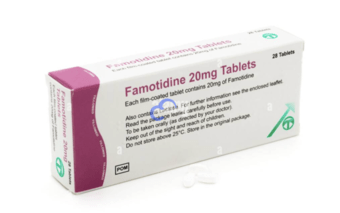Medication features
Famotidine works quickly to relieve symptoms of heartburn and acid reflux caused by an overproduction of stomach acid.
Overview
What Is Famotidine?
Famotidine tablets are a treatment for acid reflux and heartburn. Coming in either 20 mg or 40 mg tablets, famotidine belongs to the histamine-2 (H2) blocker class of medications.
Also sold under the brand name Pepcid in the UK, famotidine includes one active ingredient – famotidine – and contains inactive ingredients such as hydroxypropyl cellulose, iron oxide and hypromellose.
What Is Famotidine Used For?
Famotidine tablets are effective in treating irritation and stomach and intestinal ulcers in the oesophagus (food pipe) which are caused by acid reflux, as well as neutralising the stomach acid that causes heartburn symptoms. Famotidine can also help to prevent ulcers from coming back after they’ve healed.
How Does Famotidine Work?
Famotidine tablets treat the unpleasant symptoms in the stomach and oesophagus that are caused by excess stomach acid. H2 blockers such as famotidine stop the stomach from releasing stomach acid, which helps to relieve and prevent symptoms.
It is important that acid reflux is treated in order to prevent stomach ulcers and other complications such as oesophagitis (inflammation that can damage your food pipe), strictures (the abnormal narrowing of the oesophagus) and aspiration pneumonia (when stomach acid, food or saliva is inhaled into the lungs).
Famotidine and Alcohol
As famotidine does not have a significant effect on alcohol blood level, you can drink alcohol while taking famotidine tablets. However, alcohol may worsen the symptoms of acid reflux and heartburn, so drinking is not advised if you suffer from these conditions.
Famotidine in Pregnancy
If you are pregnant, trying for a baby, or are breastfeeding, you should speak to your doctor or pharmacist before taking famotidine tablets.
Famotidine will usually only be recommended during pregnancy if it is determined by a doctor that the benefits outweigh the risks. Usually, it is safe to take H2 blockers such as famotidine during pregnancy. Being pregnant may increase acid reflux due to the growing foetus and high levels of progesterone (known as the pregnancy hormone).
Famotidine vs Omeprazole
Like famotidine, omeprazole – also sold under the brand names Losec and Pyrocalm in the UK – is a medication that treats acid reflux and heartburn. While famotidine is an H2 blocker, omeprazole belongs in the proton pump inhibitor class of medications. Both H2 blockers and proton pump inhibitors work by decreasing stomach acid production, but proton pump inhibitors are understood to work faster in decreasing stomach acid.
While famotidine works by stopping the stomach from releasing acid, omeprazole works by blocking the proton pumps (an enzyme in the stomach lining that helps with acid production) from working properly. Omeprazole blocks acid production by around 50% on the first day, so it will typically take a few days to receive the full benefit from the medication.
Famotidine and omeprazole both come in tablet or capsule form, but can also be taken in a liquid or administered via injection. The dosage of famotidine and omeprazole differ slightly for acid reflux. Famotidine tablets are taken twice per day for acid reflux, whereas omeprazole tablets are taken only once per day for acid reflux. When taken for heartburn, the normal dosage for both medications is one tablet, once per day.
Like famotidine, omeprazole is not available to buy over the counter in the UK. To purchase omeprazole from an online, high street or supermarket pharmacy, you will need a prescription. Both treatments are available through our online pharmacy. You will need to complete an online consultation before the medication can be dispensed. Once the consultation has been approved, the medication will be sent to you in a discreet package via next-day delivery.
Famotidine vs Ranitidine
Famotidine and ranitidine are both H2 blockers which are treatments for acid reflux and heartburn. The two medications can also treat stomach ulcers. They work in a similar way, stopping the stomach from releasing stomach acid. Both come in tablet form and share some of the same potential side effects, including headache, nausea and diarrhoea.
Ranitidine has been discontinued in the UK. This is a precaution after it was found that the medication may contain an impurity that has been linked to increased cancer risk in animals. At the time of writing, it is not known if ranitidine will be made available again. If you have acid reflux or heartburn, your doctor may suggest an alternative to ranitidine, such as famotidine or omeprazole.
Famotidine Reviews
Online reviewers have cited the effectiveness of famotidine tablets in relieving frequent heartburn that is caused by acid reflux. Some users tried famotidine after several other treatments had been unsuccessful in relieving their heartburn, and found that famotidine was the first treatment that worked satisfactorily. Famotidine has been praised for its ability to control acid reflux symptoms when taken within 15 to 60 minutes before eating food. Among the side effects highlighted by users online are headache, nausea, constipation and diarrhoea.
Can You Buy Famotidine Over the Counter?
You cannot buy famotidine tablets over the counter in the UK. Before you can buy famotidine tablets, a medical professional will need to assess your suitability for the medication and issue a prescription. Once you have been issued with a prescription, you’ll be able to buy famotidine tablets online, and from high street or supermarket pharmacies.
Why not buy famotidine tablets through Cloud Pharmacy’s online service? After a consultation with one of our online pharmacists, your prescription can be issued. We will then dispense your tablets and send them via our next-day delivery service.
Directions
Famotidine Interactions
As famotidine reduces stomach acid, it may change the way that some products – which require stomach acid to absorb them – work. These products may include atazanavir, azole antifungals, dasatinib, delavirdine, levoketoconazole and pazopanib.
You shouldn’t take famotidine with other H2 blockers, or any other products that contain famotidine.
Famotidine Dosage
Famotidine tablets come in 20 mg and 40 mg doses and are usually only prescribed to adults. The usual dosage for an adult is:
- One 20 mg or 40 mg tablet, twice daily for acid reflux
- One 40 mg tablet, once per day at bedtime for stomach ulcers
The famotidine dosage prescribed by your doctor will depend on numerous factors, including:
- Your age
- The type of condition you are treating with famotidine
- The severity of the condition that you are treating with famotidine
- Any other medical conditions you have
You may be given a higher dosage of famotidine if you have switched from another H2 blocker that has been unsuccessful in relieving symptoms.
How Long Does Famotidine Take To Work?
Famotidine tablets begin to work just after you swallow them, and can relieve acid reflux symptoms, including heartburn, within 15 to 30 minutes. The effect of one famotidine tablet lasts for up to 12 hours.
You must continue to take famotidine for the amount of time recommended by your doctor. If you stop taking famotidine before the end of this recommended period, your acid reflux symptoms may not improve or may worsen.
How to Take Famotidine
Famotidine tablets should be swallowed whole with water. Never crush, break or chew famotidine tablets. When you take famotidine tablets will depend on your dosage – for acid reflux, you would normally take famotidine tablets twice per day, 15 minutes to an hour before a meal. For stomach ulcers, you would normally take famotidine tablets once per day, before bedtime.
If you forget to take a dose of famotidine, you should take it as soon as you remember. However, if you don’t remember until the next day, simply skip the missed dose and take your doses at the normal time the following day. Don’t take two doses to compensate for missing a dose.
Side Effects
Famotidine Side Effects
There are various side effects associated with taking famotidine tablets. Among the most common potential side effects are:
- Headache
- Nausea
- Diarrhoea
- Constipation
- Vomiting
- Fatigue
- Loss of appetite
- Stomach pain
- Flatulence
- Dry mouth
These side effects are typically mild and will get better without any treatment being required. If any of the side effects above persist, or you are concerned about them, speak to your doctor.
Serious side effects from famotidine are rare. If you experience any of the following symptoms, you should stop taking the medication at once and contact a medical professional or call 999:
- A fast, irregular or pounding heartbeat
- Swelling
- Breathing difficulty
- Unusual bruising or bleeding
- Skin rash or blisters
- Unexplained muscle pain or weakness
Patient Information Leaflet
Famotidine Tablets Patient Information Leaflet
For more information on Famotidine medication, take a look at the Patient Information Leaflet below:
Famotidine Tablets FAQs
What is Acid Reflux?
It is the movement of the stomach contents up the oesophagus or gullet. Often causing an uncomfortable or burning sensation behind the breastbone.
In more serious or left untreated, Stomach contents can be regurgitated into the mouth affecting the teeth, gums and causing bad breath.
Sometimes the regurgitated fluid can enter the airways and exacerbate or make asthma worse.
What causes Acid Reflux?
The stomach has a small circular piece of muscle at the top, called the cardiac or lower oesophageal sphincter.
This stops the stomach contents from travelling back up the oesophagus or gullet.
When this muscle becomes weakened, the stomach contents can travel up and cause symptoms like heartburn, bad breath and the feeling of being sick.
Is Acid Reflux common?
It is very common and 60% of people will have reflux or similar symptoms in a 12-month period.
In the same period, 20-30% of people will have symptoms on a weekly basis.
What are the symptoms of Acid Reflux?
The movement of acid can give the following symptoms
- Burning feeling behind the breastbone
- Feeling sick
- Being sick
- Bad breath
- Tooth and gum problems
- Worsening of asthma
What can make Acid Reflux worse?
The following can make acid reflux worse.
- Being overweight or obese
- Smoking
- Eating spicy food,
- Large meal sizes
- Late night Eating, within 2 hours of going to sleep
- Alcohol
- Coffee
- Chocolate
- Pregnancy
- Tight Clothing
- Certain medicines for blood pressure like Calcium channel blockers, medicines for angina like glyceryl trinitrate and painkillers like ibuprofen, diclofenac and other anti-inflammatory drugs.
- Stress
- Genetics
How do I choose the correct treatment for Acid Reflux?
There are different categories of treatment and their uses and explanations are listed below.
Generally, patients should start with antacids and then make their way down the list if treatment does not control their symptoms.
1. Antacids – the first line treatment. These help neutralise stomach acid to relieve symptoms. The effects usually last for 2-3 hours. Examples of antacids include Rennie, Enos, Andrews Salts, and Tums. They contain ingredients like calcium carbonate, which neutralizes stomach acid, but too much calcium taken regularly can make acid reflux worse. Only be for occasional or infrequent use.
2. Alginates – neutralize and form a layer on the top of stomach acid, which prevents upward movement. Are available in tablet and liquid forms. Liquids act quicker but are more inconvenient to carry around. Usually, these last no more than 3-4 hours.
Alginates are made up of calcium carbonate, magnesium carbonate or aluminum salts. Too much calcium taken frequently can cause stomach acid to worsen, so should only be used infrequently. Excessive magnesium salts can cause diarrhoea and too much aluminum salts can cause constipation.
Always check with pharmacist, as alginates can interact with other medication. Examples include Gaviscon, Gaviscon Advance, and Peptac.
3. H2 Receptor Antagonists – available as tablets. They reduce the production of stomach acid and were initially introduced on prescription, before being available to buy from pharmacies. They start to work in as little as 30 minutes and their effects can last for up to 12 hours. They are well tolerated and side effects are rare. They can include diarrhoea, tiredness, rashes, and constipation. Examples include Ranitidine, Zantac, Gavilast, Cimetidine, and Pepcid AC.
4. Proton Pump Inhibitors – or PPIs for short, are the latest medicine for controlling acid reflux and other stomach symptoms. They work by reducing the stomach acid, but are more effective and last longer. Effects can be seen up to 17 hours after the dose is taken. They come in tablet or capsule forms, be should be swallowed whole (Losec Tablets can be crushed if needed). PPIs are very well tolerated, with low incidence of side effects. Usually, unwanted effects include diarrhoea, constipation, drowsiness. Examples include Omeprazole, Lansoprazole, Losec and Esomeprazole.
Related Guides
Delve into a variety of content written by our medical experts
Famotidine Tablets Reviews
Confirm Famotidine Tablets treatment selection
| 20mg | 28 | £31.99 |
| 20mg | 56 | £60.98 |
| 20mg | 84 | £91.47 |
















